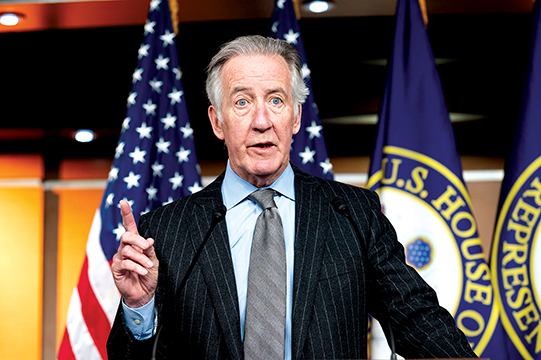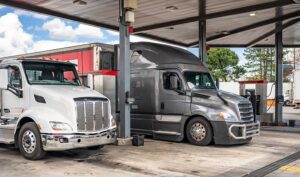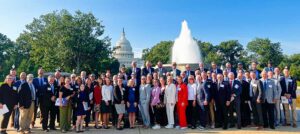Moving Forward for the People.
America’s Transportation Infrastructure Act.
Build America Fund.
These are proposals from Democrats, Republicans, and industry groups, working separately and — all too rarely — together to address the country’s deteriorating infrastructure. When something is finally accomplished, like the Fixing America’s Surface Transportation (FAST) Act signed into law in 2015, it’s often a case of too little too late. Proposals to replace the FAST Act suffer from the same malady.
The most recent Report Card from the American Society of Civil Engineers (ASCE), issued in 2017, claims it will take $420 billion to bring the nation’s roads up to acceptable standards, plus another $123 billion for needed bridge repairs. While this is necessary work, it doesn’t address the bottlenecks, which cause massive travel delays, or safety innovations that could reduce accident risks. Add another $167 billion for system expansion and $126 billion for enhancements, according to ASCE.
The needed total funding of $836 million is a far cry from the $305 billion approved in the FAST Act — and between monetary inflation and further deterioration, the total funding needed has undoubtedly risen.
In his 2019 State of the Union address, President Donald Trump discussed the seriousness of the problem. “I know that the Congress is eager to pass an infrastructure bill,” he stated, “and I am eager to work with you on legislation to deliver new and important infrastructure investment, including investments in the cutting-edge industries of the future. This is not an option. This is a necessity.”
The president also warned against partisan bickering. “Victory is not winning for our party,” he said. “Victory is winning for our country.”
After a year, are the parties any closer to a dialogue about infrastructure?
In his 2020 State of the Union address given on Feb. 4, Trump devoted a scant two sentences to highway infrastructure, saying, “We must also rebuild America’s infrastructure. I ask you to pass Sen. (John) Barrasso’s, R-Wyo., highway bill — to invest in new roads, bridges, and tunnels across our land.” Both sides of the aisle stood to applaud this sentiment in a rare mark of bipartisan approval during the address.
Trump ended his address by stating, “Our spirit is still young; the sun is still rising; God’s grace is still shining; and my fellow Americans, the best is yet to come!”
Meantime, progress on infrastructure spending grinds along in the slow lane. Barrasso’s bipartisan highway bill S. 2302, America’s Transportation Infrastructure Act (ATIA), was introduced to the Senate July 29, 2019. On July 30, the Environment and Public Works Committee unanimously advanced S. 2302, and it is now awaiting further action in the Senate. The bill calls for $297 billion in highway spending between 2021 and 2025; plus additional funding for critical Interstate projects ($5.5 billion); bridge repair ($6 billion); safety incentives ($500 million); and reduction of wildlife-vehicle collisions ($250 million).
In a Nov. 19 op-ed piece for the Washington Times, cowriters Barrasso and bill cosponsor Sen. Tom Carper, D-Del., wrote, “Our highways and transportation infrastructure are critical to our country’s success. They are vital arteries of commerce, connecting rural areas to major cities. It’s time to make a significant investment in them.”
Those comments are in stark contrast to an Aug. 15 editorial in the Washington Times in which author David A. Ditch called the bill “severely flawed, layering newly minted handouts on top of long-running policy problems.” Of particular concern is the Highway Trust Fund, which is presently inadequate to fund needed highway spending. Ditch criticized proposed spending on green initiatives such as carbon-emissions reduction, charging stations for electric vehicles, and funding for walking and biking trails.
Another issue is determining the final cost of the bill. In a summary of the bill’s provisions issued by Barrasso and Carper, no total expenditure is specified. The bill lists $287 billion for highway spending over five years, stating that it’s a 27% increase over the FAST Act currently in effect. Other projects are listed, but it’s unclear if funding is to come from the $287 billion listed for highways or from other sources.
Despite the ATIA being a bipartisan effort, House Democrats have their own bill. As January came to an end, House Transportation & Infrastructure Committee Chair Peter DeFazio, D-Ore., Ways and Means Committee Chair Richard Neal, D-Mass., and Energy and Commerce Committee Chair Frank Pallone, D-N.J., have introduced their own $760 billion bill to the House of Representatives.
“Due to decades of underfunding and neglect, America’s infrastructure system is falling apart, and we’re falling behind our global competitors,” said Neal. “The deficiencies of our roads, bridges, transit, water systems, broadband, and electrical grids hold our nation’s economy back.”
The House bill calls for $329 billion in highway and highway-safety spending. The highway spending includes funding for an increase of electric-vehicle charging stations and alternative fueling options.
Additionally, $431 billion would be directed to nonhighway investment, such as $105 billion for mass transit upgrades; $55 billion for rail improvements, including investment in Amtrak; and another $30 billion for airport improvements. $34.3 billion would be directed toward clean energy; $25.4 billion toward clean drinking water; and $50.5 billion for water and wastewater infrastructure; with $98 billion slated for broadband and communications.
One item missing from both infrastructure bills? How to pay for all of it.
The Highway Trust Fund (HTF) and how it will be replenished is the elephant in the highway-spending room. It’s obvious that current funding methods won’t get the job done. The HTF is expected to be completely depleted by 2021, according to the Congressional Budget Office, which predicts a $138 billion shortfall by the year 2027.
To eliminate the backlog of needed repairs, however, a fuel tax increase is the most likely solution — for now. Despite inflation, the federal fuel tax hasn’t been raised since 1993.
One proposed solution from the American Trucking Associations (ATA), backed by the Truckload Carriers Association (TCA), is the Build America Fund (BAF). In its “7 Essentials to Understanding the Build America Fund,” the ATA points out that the federal government will need to raid the general treasury to complement what’s left in the HTF or risk cancellation or delay of critical transportation projects.
TCA Vice President of Government Affairs David Heller is firmly in the raise-fuel-taxes camp.
“Fuel taxes are the easiest and most efficient way of paying for roads and bridges,” he said, explaining that no other funding method puts a greater percentage of dollars collected into construction. Indeed, the BAF release claims that administrative costs for fuel taxes are less than 1% of revenue, leaving over 99% to go directly to the HTF. Toll operations take between 12% and 33.5% of revenues for administrative costs, according to the release.
Another issue is the use of HTF dollars to fund nonhighway projects such as expanding broadband networks and public-transportation projects. “The purpose of the Highway Trust Fund is to pay for roads and bridges, but unfortunately, funds are continually siphoned off for other purposes,” said Heller.
The TCA-supported proposal to fund the HTF calls for a $0.20 increase in fuel taxes, applied at the wholesale terminal rack, meaning the tax would be collected as the fuel is loaded on the delivery truck. The increase would be limited to $0.05 per gallon each year until the full $0.20 is reached.
In 10 years, the fund is expected to generate $340 billion to the HTF, keeping it solvent while repairs are made and alternative forms of funding are explored.
A similar proposal was introduced to the House of Representatives by Rep. Earl Blumenauer, D-Ore., on May 21, 2019. In a statement posted on his website, Blumenauer stated, “It is past time that we get real about funding our infrastructure needs. We can’t afford inaction any longer.” H.R. 2864, the Rebuild America Act of 2019, was quickly referred to the House Ways and Means Committee, where it remains.
Like the BAF, Blumenauer’s bill proposes a $0.05 per gallon increase each year — but for five years, making the total tax increase $0.25 per gallon.
The bill also presses Congress to replace the fuel tax with a more sustainable system by 2029.
So, there is an infrastructure bill in each chamber of Congress, along with a bill in the house to raise fuel taxes to help fund repairs and growth. None of the proposals are moving quickly, but there’s hope.
“The good news is that more people are talking,” said Heller. “That doesn’t mean that more people are finding a consensus, but discussion is occurring.”
More discussion was expected at a bipartisan forum Feb. 16 at the University of Nevada in Las Vegas. The host of the event, United for Infrastructure, is a nonprofit, nonpartisan organization “dedicated to educating the public and policymakers about the importance of America’s infrastructure,” according to the group’s website. Sponsored by an assortment of organizations and labor unions, including ASCE, the “Moving America Forward Forum” is designed to give presidential candidates a platform for addressing infrastructure issues and their solutions.
Whether within the halls of Congress or offsite at a sponsored forum, the talks should intensify as November looms closer. “Infrastructure is a fairly major political point right now. It’s being discussed in more and more committees in both houses,” said Heller. “As we get closer to the election, more politicians will want to be able to tell their constituents that they got something done.”
One major discussion took place in the House Ways and Means Committee in January. Addressing the “On Paving the Way for Funding and Financing Infrastructure Investments” hearing, Madrus, LLC Founder DJ Gribbin, former General Counsel to the U.S. Department of Transportation, claimed that ownership of the infrastructure was part of the problem. “Even by the broadest definition, the federal government owns less than 7% of the nation’s public, nondefense infrastructure,” said Gribbin. For highways and streets, the percentage is only 1%. His point is that all tax dollars come from the community, but dollars that are collected and then distributed by the federal government are often wasted because of inefficiency. “While the collection of the gas tax is wonderfully efficient, the expenditure of those funds is not,” he said.
New Jersey Department of Transportation Commissioner Diane Gutierrez-Scaccetti addressed the committee sharing, “There is no more important funding decision than that which involves this nation’s transportation network,” she said. Addressing fuel taxes, she said, “It is the single most important mechanism to generate significant revenue necessary to maintain and improve our transportation network.”
eBooleant Consulting LLC Founder Dr. Phillip J. Fischer stressed the importance of making funds available for state and local governments to borrow for infrastructure projects, suggesting several avenues for issuing bonds to raise cash.
As Heller said, “Discussion is occurring.” While Heller supports funding the HTF with fuel taxes, he also has an eye to the future. Sales of electric automobiles are on the rise, and truck manufacturers are getting closer to a feasible model for over-the-road use.
“People are talking about a VMT (vehicle miles traveled tax) as a replacement for the fuel tax,” said Heller. “But I don’t think the country is ready for it.”
Heller is addressing another infrastructure problem that looms on the horizon. Electric vehicles, including trucks, are limited by the range of their batteries. Most electric vehicles are limited to an area that allows them to return to their point of origin for a recharge. With government-provided incentives, stations that allow recharging without returning home may soon be as common as today’s gas stations.
Incentivizing the building of a network of charging stations is easier than figuring out how to raise tax dollars from the stations. A VMT could be a solution. Technology exists to collect this tax in various ways. A simple method is to require owners to report mileage each time they renew registration on their vehicles, paying any taxes due at that time. However, paying a year’s worth of VMT at a time could be objectionable to many vehicle owners. Devices like those used in tolling and scale-bypass applications can be adapted to read a vehicle’s odometer at certain locations, like charging stations, adding VMT to the cost of charging. Similar systems have been used in Europe at gas and diesel pumps.
No one knows for certain what will power trucking fleets a decade or two down the road, but one fact remains: A method of acquiring funding to maintain roads and bridges will need to be found and adapted. At the rate Congress is moving to approve current funding, more cooperation will be needed to implement a replacement strategy for fuel taxes.
Until Congressional leaders replace bickering with bargaining and contention with consensus, the answers remain elusive.
Cliff Abbott is an experienced commercial vehicle driver and owner-operator who still holds a CDL in his home state of Alabama. In nearly 40 years in trucking, he’s been an instructor and trainer and has managed safety and recruiting operations for several carriers. Having never lost his love of the road, Cliff has written a book and hundreds of songs and has been writing for The Trucker for more than a decade.















